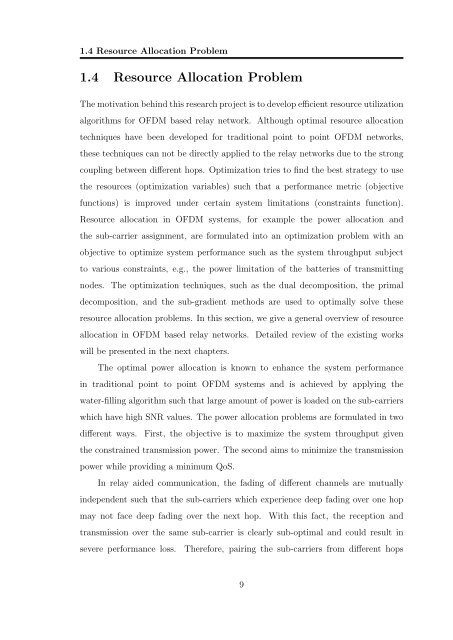Resource Allocation in OFDM Based Wireless Relay Networks ...
Resource Allocation in OFDM Based Wireless Relay Networks ...
Resource Allocation in OFDM Based Wireless Relay Networks ...
Create successful ePaper yourself
Turn your PDF publications into a flip-book with our unique Google optimized e-Paper software.
1.4 <strong>Resource</strong> <strong>Allocation</strong> Problem<br />
1.4 <strong>Resource</strong> <strong>Allocation</strong> Problem<br />
The motivation beh<strong>in</strong>d this research project is to develop efficient resource utilization<br />
algorithms for <strong>OFDM</strong> based relay network. Although optimal resource allocation<br />
techniques have been developed for traditional po<strong>in</strong>t to po<strong>in</strong>t <strong>OFDM</strong> networks,<br />
these techniques can not be directly applied to the relay networks due to the strong<br />
coupl<strong>in</strong>g between different hops. Optimization tries to f<strong>in</strong>d the best strategy to use<br />
the resources (optimization variables) such that a performance metric (objective<br />
functions) is improved under certa<strong>in</strong> system limitations (constra<strong>in</strong>ts function).<br />
<strong>Resource</strong> allocation <strong>in</strong> <strong>OFDM</strong> systems, for example the power allocation and<br />
the sub-carrier assignment, are formulated <strong>in</strong>to an optimization problem with an<br />
objective to optimize system performance such as the system throughput subject<br />
to various constra<strong>in</strong>ts, e.g., the power limitation of the batteries of transmitt<strong>in</strong>g<br />
nodes. The optimization techniques, such as the dual decomposition, the primal<br />
decomposition, and the sub-gradient methods are used to optimally solve these<br />
resource allocation problems. In this section, we give a general overview of resource<br />
allocation <strong>in</strong> <strong>OFDM</strong> based relay networks. Detailed review of the exist<strong>in</strong>g works<br />
will be presented <strong>in</strong> the next chapters.<br />
The optimal power allocation is known to enhance the system performance<br />
<strong>in</strong> traditional po<strong>in</strong>t to po<strong>in</strong>t <strong>OFDM</strong> systems and is achieved by apply<strong>in</strong>g the<br />
water-fill<strong>in</strong>g algorithm such that large amount of power is loaded on the sub-carriers<br />
which have high SNR values. The power allocation problems are formulated <strong>in</strong> two<br />
different ways. First, the objective is to maximize the system throughput given<br />
the constra<strong>in</strong>ed transmission power. The second aims to m<strong>in</strong>imize the transmission<br />
power while provid<strong>in</strong>g a m<strong>in</strong>imum QoS.<br />
In relay aided communication, the fad<strong>in</strong>g of different channels are mutually<br />
<strong>in</strong>dependent such that the sub-carriers which experience deep fad<strong>in</strong>g over one hop<br />
may not face deep fad<strong>in</strong>g over the next hop. With this fact, the reception and<br />
transmission over the same sub-carrier is clearly sub-optimal and could result <strong>in</strong><br />
severe performance loss. Therefore, pair<strong>in</strong>g the sub-carriers from different hops<br />
9

















